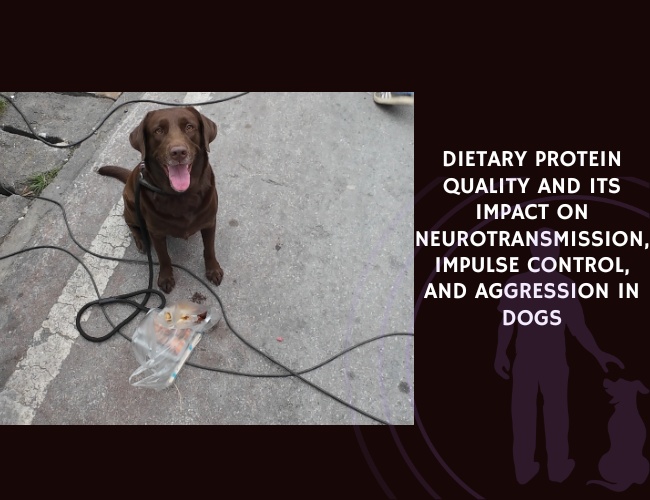Introduction: The Hidden Link Between Your Dog’s Bowl and Their Behavior
Have you ever wondered why your energetic Border Collie seems more focused after certain meals, or why your rescue pup’s anxiety levels fluctuate with dietary changes? The answer might lie deeper than you think—right down to the molecular level of the proteins in their bowl. Today, let us guide you through the fascinating world of dietary protein quality and its profound impact on your dog’s mood, impulse control, and overall behavior.
For decades, we’ve understood that proper nutrition keeps our dogs physically healthy, but emerging research reveals something remarkable: the quality of protein your dog consumes directly influences their brain chemistry, affecting everything from their ability to learn new commands to how they handle stress. This isn’t just about feeding your furry friend—it’s about nourishing their mind and supporting their emotional wellbeing through every meal. 🧡
As we explore this journey together, you’ll discover how amino acids act as building blocks for happiness hormones, why your high-drive working dog might need a different protein strategy than your laid-back lapdog, and how timing your dog’s meals could transform your training sessions. Whether you’re dealing with aggression issues, impulse control challenges, or simply want to optimize your dog’s behavioral health, understanding protein quality gives you a powerful tool in your caregiving toolkit.
Understanding the Brain-Bowl Connection
The Neurotransmitter Highway: How Food Becomes Mood
When your dog takes that first bite of their meal, they’re not just satisfying hunger—they’re initiating a complex cascade of neurochemical events. Proteins break down into amino acids, which then travel through the bloodstream and cross the blood-brain barrier, where they transform into the very chemicals that regulate your dog’s emotions and behaviors. Think of it as a highway system where the quality of the “vehicles” (amino acids) determines how smoothly “traffic” (neural signals) flows.
The Serotonin Story: You might notice your dog seems calmer and more content after certain meals. This isn’t your imagination—it’s serotonin at work. This “happiness hormone” derives from tryptophan, an essential amino acid found abundantly in high-quality proteins. When serotonin levels are optimal, your dog experiences better impulse control, reduced anxiety, and that gentle, relaxed demeanor we all love. Low serotonin, however, can manifest as increased reactivity, difficulty settling, or even aggressive responses to everyday triggers.
The Dopamine Drive: While serotonin soothes, dopamine motivates. This neurotransmitter, synthesized from the amino acid tyrosine, fuels your dog’s drive to work, play, and engage with their world. It’s what makes your retriever obsessed with fetching or gives your terrier that unstoppable prey drive. The right balance of dopamine keeps your dog engaged without becoming hyperactive or obsessive—a delicate balance that protein quality directly influences.
Quality Matters: Not All Proteins Are Created Equal
Picture two bowls of dog food sitting side by side. Both claim “high protein” on the label, but one contains premium chicken meal while the other lists “meat by-products” as its primary source. The difference in behavioral outcomes between these two foods can be dramatic, and here’s why:
Complete Amino Acid Profiles: High-quality proteins contain all essential amino acids in bioavailable forms. This means your dog’s body can readily absorb and utilize them for neurotransmitter production. Premium sources like whole chicken, fish, eggs, and lamb provide these complete profiles naturally.
Bioavailability and Absorption: Even if a protein source contains the right amino acids, your dog’s digestive system must be able to extract and absorb them efficiently. Low-quality proteins often come from rendered materials or plant sources that dogs struggle to process fully, leading to amino acid deficiencies despite adequate protein percentages on paper.
The Processing Factor: How protein sources are processed matters tremendously. Gently cooked or freeze-dried proteins retain more of their amino acid integrity compared to heavily processed meat meals that have been subjected to extreme heat and pressure. This preservation of nutritional quality translates directly to better behavioral outcomes.
Behavioral Manifestations of Protein Quality
When Good Dogs Eat Bad Protein: Recognizing the Signs
You might not immediately connect your dog’s behavioral challenges with their diet, but the signs are often clear once you know what to look for. Dogs consuming low-quality protein sources frequently exhibit a constellation of symptoms that caring owners might mistake for training issues or personality quirks.
Increased Reactivity and Aggression: Without adequate tryptophan to produce serotonin, dogs become more reactive to environmental triggers. That normally friendly golden retriever might start resource guarding, or your usually tolerant family dog might snap at children during play. These aren’t character flaws—they’re neurochemical imbalances crying out for nutritional intervention.
Impulse Control Challenges: Have you noticed your dog struggling with basic commands they once knew perfectly? Low-quality protein can impair the prefrontal cortex’s ability to regulate impulses. Your dog knows they shouldn’t jump on guests or steal food from the counter, but their brain literally lacks the chemical resources to control these impulses effectively.
Anxiety and Hypervigilance: Dogs on poor-quality protein diets often display heightened anxiety. They might pace excessively, struggle to settle even after exercise, or react fearfully to normal household sounds. This chronic stress state stems from imbalanced neurotransmitter production, creating a vicious cycle where anxiety further depletes their already limited neurochemical resources.
The Transformation: What Happens with Premium Protein
The behavioral transformation that occurs when dogs switch to high-quality protein sources can seem almost miraculous to owners who’ve struggled with behavior issues. Within weeks—sometimes even days—of dietary improvement, remarkable changes begin to unfold.
Enhanced Learning Capacity: With optimal dopamine and serotonin levels, your dog’s brain becomes primed for learning. Training sessions that once ended in frustration become productive and enjoyable. Commands stick better, new behaviors are acquired faster, and your dog shows improved problem-solving abilities. It’s like upgrading from dial-up to high-speed internet in their neural networks.
Emotional Stability: High-quality protein supports consistent neurotransmitter production throughout the day, eliminating the peaks and valleys that contribute to mood swings. Your dog develops what behaviorists call “emotional resilience”—the ability to encounter stressors without overreacting. That doorbell that used to trigger frantic barking becomes just another sound in their day.
Improved Social Interactions: Dogs receiving adequate amino acids for neurotransmitter synthesis show marked improvements in social behavior. They read other dogs’ body language more accurately, respond appropriately to social cues, and maintain better relationships with both canine and human family members. Play becomes more regulated, and conflicts decrease significantly. 🐾
Breed-Specific Protein Strategies
High-Drive Breeds: Fueling the Fire Safely
Working breeds like Belgian Malinois, Border Collies, and German Shepherds possess genetic programming for intense focus and drive. These remarkable dogs require specialized protein strategies to channel their energy constructively while maintaining behavioral balance.
The Working Dog’s Dilemma: High-drive breeds naturally produce more dopamine, giving them their characteristic intensity and work ethic. However, this can tip into hyperactivity or obsessive behaviors without proper nutritional support. These dogs need protein sources rich in both tyrosine (for their dopamine-driven work) and tryptophan (to maintain impulse control).
Optimal Protein Sources for High-Drive Dogs:
- Wild-caught fish (salmon, sardines): Provides complete proteins plus omega-3s for cognitive function
- Grass-fed beef: High in B-vitamins that support neurotransmitter synthesis
- Free-range poultry: Balanced amino acid profile with high bioavailability
- Eggs: Nature’s perfect protein, supporting both energy and calm
Feeding Frequency and Portion Control: These breeds often benefit from smaller, more frequent meals to maintain stable blood sugar and consistent amino acid availability. Rather than one or two large meals, consider three moderate portions spread throughout the day, timed around training and work sessions.
Low-Drive and Companion Breeds: Gentle Support for Gentle Souls
Breeds like Cavalier King Charles Spaniels, Shih Tzus, and Basset Hounds have different neurochemical needs than their high-drive counterparts. These dogs thrive on protein strategies that support calm, stable temperaments without overstimulating their more modest energy systems.
The Companion Dog’s Balance: Low-drive breeds typically produce less baseline dopamine, which contributes to their calm, easygoing nature. However, they still require quality protein to maintain healthy serotonin levels for emotional wellbeing and prevent anxiety or depression-like symptoms.
Tailored Protein Approaches:
- Moderate protein percentages (22-26%) from high-quality sources
- Emphasis on tryptophan-rich proteins like turkey and cottage cheese
- Incorporation of novel proteins like venison or duck for variety
- Careful portion control to prevent obesity, which can affect mood
Special Considerations: These breeds often have slower metabolisms and may be prone to weight gain. Quality becomes even more important than quantity—every bite must count nutritionally to support behavioral health without contributing to obesity-related mood issues.

Senior Dogs: Adjusting for Age-Related Changes
As your faithful companion enters their golden years, their protein needs shift in complex ways. The aging brain requires different nutritional support to maintain cognitive function and emotional stability.
Neurological Changes with Age: Senior dogs experience natural decreases in neurotransmitter production and receptor sensitivity. This can manifest as increased anxiety, confusion, or changes in sleep patterns. High-quality, easily digestible proteins become crucial for supporting their changing neurochemistry.
Senior-Specific Protein Strategies:
- Increased focus on digestibility (hydrolyzed proteins, gentle cooking methods)
- Higher tryptophan ratios to support sleep and reduce anxiety
- Incorporation of medium-chain triglycerides for cognitive support
- Careful monitoring of kidney function when adjusting protein levels
The Science of Protein Timing
Pre-Training Protein: Setting the Stage for Success
The concept of protein timing might seem like something reserved for elite athletes, but it’s equally important for our canine companions. When you feed protein relative to training sessions can dramatically impact your dog’s ability to learn and retain new behaviors.
The 90-Minute Window: Research suggests that consuming high-quality protein 60-90 minutes before training optimizes amino acid availability during learning. This timing allows for initial digestion and absorption, ensuring that tryptophan and tyrosine are circulating in the bloodstream when your dog needs them most.
Morning Training Advantage: Many trainers report better results with morning sessions preceded by a small, protein-rich meal. This takes advantage of naturally higher cortisol levels (which aid learning) while providing the nutritional support for neurotransmitter production. Try offering 25% of your dog’s daily protein intake 90 minutes before morning training for optimal results.
What to Feed: Pre-training protein should be easily digestible and balanced. Consider:
- A small portion of cooked chicken breast
- Plain Greek yogurt (for dogs who tolerate dairy)
- A high-quality protein treat specifically designed for training
- Scrambled eggs (without added fats or seasonings)
Post-Exercise Recovery: Rebuilding and Reinforcing
After an intense training session or vigorous exercise, your dog’s brain and body need specific nutritional support to consolidate learning and recover from exertion. This is where strategic protein timing becomes particularly powerful.
The Learning Consolidation Phase: The hours immediately following training are critical for memory formation. Adequate protein during this window supports the synthesis of proteins necessary for creating long-term memories. This means the commands and behaviors practiced during training are more likely to “stick.”
Timing and Composition: Within 30 minutes of completing training or exercise, offer a protein-rich recovery meal or snack. This should comprise:
- 30-40% of daily protein intake for high-drive working dogs
- 20-25% for companion breeds or less intensive training
- A mix of fast and slow-digesting proteins for sustained amino acid release
- Adequate hydration to support nutrient transport
Behavioral Benefits: Dogs who receive properly timed post-exercise protein show improved recovery, better mood stability, and enhanced retention of trained behaviors. You might notice your dog is calmer in the evening, sleeps better, and shows improved performance in subsequent training sessions.
Evening Protein: Supporting Restorative Sleep
The protein your dog consumes in their evening meal plays a crucial role in overnight neurotransmitter synthesis and behavioral regulation the following day. This often-overlooked aspect of protein timing can make the difference between a well-rested, balanced dog and one prone to morning anxiety or hyperactivity.
Tryptophan for Sleep: Evening meals should emphasize tryptophan-rich proteins to support serotonin and melatonin production. Turkey, cottage cheese, and certain fish provide ideal evening protein sources. This natural approach to supporting sleep can be particularly helpful for dogs with anxiety or those adjusting to new environments.
Portion Considerations: The evening meal should contain adequate protein without overloading the digestive system before sleep. Aim for:
- 35-40% of daily protein intake for most adult dogs
- Served 2-3 hours before bedtime
- Combined with easily digestible carbohydrates to enhance tryptophan uptake
- Avoiding high-fat additions that might disrupt sleep
Fuel. Focus. Balance.
Nutrition shapes the mind. The quality of protein in your dog’s diet directly impacts neurotransmitter production, influencing mood, impulse control, and the ability to learn. Feeding the right building blocks supports emotional stability as much as physical health.
Amino acids drive behavior. Tryptophan fosters calm through serotonin, while tyrosine fuels motivation via dopamine. Balanced, bioavailable protein sources help regulate these systems, preventing reactivity, anxiety, and focus loss.



Quality transforms outcomes. Switching from low-grade to premium proteins can sharpen learning, steady emotions, and improve social interactions—unlocking your dog’s full cognitive and behavioral potential.
Troubleshooting Behavioral Issues Through Protein
Aggression and Reactivity: A Nutritional Approach
When dealing with aggression issues, many owners focus solely on training while overlooking the fundamental role nutrition plays in their dog’s ability to regulate aggressive impulses. Understanding how protein quality influences aggression can open new pathways to helping reactive dogs.
The Serotonin-Aggression Connection: Studies consistently show that dogs with aggression issues often have lower serotonin levels than their non-aggressive counterparts. By increasing dietary tryptophan through high-quality protein sources, we can naturally boost serotonin production and reduce aggressive tendencies. This doesn’t replace behavior modification but creates a neurochemical environment where training can be more effective.
Implementation Strategy:
- Begin with a baseline behavior assessment
- Transition gradually to high-tryptophan protein sources
- Monitor and document behavioral changes over 4-6 weeks
- Adjust protein timing to support training sessions
- Combine with appropriate behavior modification protocols
Case Example: Consider Max, a German Shepherd with leash reactivity. After switching from a grocery store brand (with meat by-products) to a premium food featuring wild-caught salmon and turkey, his owners noticed decreased lunging within two weeks. Combined with counter-conditioning training, Max’s improvement accelerated dramatically. The protein change didn’t cure his reactivity but gave his brain the resources needed to learn new, calmer responses.
Anxiety and Fear: Building Confidence Through Nutrition
Anxious dogs live in a state of chronic stress that depletes their neurotransmitter reserves, creating a cycle where anxiety begets more anxiety. Strategic protein supplementation can help break this cycle and build resilience.
The Anxiety Protocol:
- Morning: High-quality, tryptophan-rich protein to establish calm baseline
- Midday: Small protein snack to maintain stable amino acid levels
- Evening: Balanced protein with calming supplements (L-theanine, if recommended by vet)
- Avoid: Protein sources that might cause digestive upset, adding to stress
Supporting Fearful Dogs: Fear-based behaviors often improve when dogs receive consistent, high-quality protein that supports both serotonin (for emotional regulation) and dopamine (for confidence-building). Novel protein sources can be particularly helpful, as they often contain unique amino acid profiles that support neural diversity.
Environmental Considerations: Remember that protein quality works synergistically with environmental management. A fearful dog eating premium protein but living in chaos won’t show the same improvement as one in a structured, predictable environment. Combine nutritional support with:
- Consistent daily routines
- Safe spaces for retreat
- Gradual, positive exposure to triggers
- Regular, appropriate exercise
Hyperactivity and Focus Issues: Finding Balance
That bouncing-off-the-walls energy that some dogs display isn’t always just personality—it can be a sign of nutritional imbalance affecting their ability to regulate arousal and attention. The right protein strategy can help these dogs find their calm without dampening their natural enthusiasm.
The Dopamine-Focus Relationship: While dopamine drives motivation and engagement, too much can lead to scattered attention and hyperactivity. The key lies not in reducing protein but in balancing amino acids to support both dopamine and serotonin production appropriately.
Practical Adjustments:
- Switch to proteins with balanced amino acid profiles (whole eggs, fish)
- Avoid single-source proteins that might create imbalances
- Time meals to avoid protein intake close to exciting activities
- Consider digestive enzymes to improve protein utilization
The Attention Diet: For dogs with focus issues, consider:
- Breakfast: Moderate protein with complex carbohydrates
- Pre-training snack: Small amount of easily digestible protein
- Post-training meal: Higher protein to support learning consolidation
- Dinner: Tryptophan-rich proteins for evening calm

Creating Your Dog’s Optimal Protein Plan
Assessment: Understanding Your Dog’s Unique Needs
Before adjusting your dog’s protein intake, it’s essential to understand their individual requirements. Every dog is unique, and what works for your neighbor’s Labrador might not suit your Corgi. Let’s explore how to assess your dog’s specific needs.
Baseline Behavior Documentation: Start by keeping a behavior diary for one week. Note:
- Energy levels throughout the day
- Reactivity to common triggers
- Training responsiveness
- Sleep patterns
- Social interactions with humans and other dogs
- Any aggressive or anxious behaviors
Physical Health Considerations: Work with your veterinarian to evaluate:
- Current weight and body condition score
- Kidney and liver function (especially important for senior dogs)
- Any food sensitivities or allergies
- Digestive health and stool quality
- Overall health status and any medications
Lifestyle Factors: Consider your dog’s daily life:
- Exercise intensity and duration
- Training or work requirements
- Stress levels in the home environment
- Interaction with other pets or children
- Changes or transitions (moving, new family members, etc.)
Implementation: Making the Transition
Once you understand your dog’s needs, implementing a high-quality protein plan requires patience and systematic approach. Sudden dietary changes can cause digestive upset and behavioral stress, potentially masking the benefits you’re trying to achieve.
The Gradual Transition Protocol:
- Days 1-3: Replace 25% of current food with new, high-quality protein source
- Days 4-6: Increase to 50% new food
- Days 7-9: Move to 75% new food
- Day 10+: Complete transition to new protein plan
Monitoring During Transition: Watch for:
- Digestive changes (some adjustment is normal)
- Energy level fluctuations
- Behavioral improvements or changes
- Appetite and enthusiasm for meals
- Skin and coat condition changes
Fine-Tuning Your Approach: After the initial transition, you might need to adjust:
- Protein percentage based on activity level
- Specific protein sources for optimal results
- Meal timing to support your schedule
- Portion sizes for weight management
- Supplement additions if recommended by your vet
Long-Term Success: Maintaining Behavioral Health
Creating lasting behavioral change through nutrition requires commitment to long-term monitoring and adjustment. Your dog’s needs will evolve with age, seasons, and life circumstances.
Seasonal Adjustments: Many dogs require different protein strategies in summer versus winter. Cold weather often increases caloric needs, while hot weather might require lighter, more digestible proteins. Pay attention to:
- Activity level changes with weather
- Seasonal anxiety (thunderstorms, fireworks)
- Coat changes requiring different nutritional support
- Weight fluctuations with activity changes
Life Stage Transitions: As your dog moves through life stages, their protein needs shift:
- Adolescence (6-18 months): Higher protein for growth and typically increased activity
- Adult maintenance (2-7 years): Stable, high-quality protein for sustained health
- Senior years (7+ years): Adjusted protein with focus on digestibility and cognitive support
- Geriatric (10+ years): Carefully balanced protein considering organ function
Tracking Success Markers: Document improvements in:
- Training retention and learning speed
- Emotional resilience to stressors
- Social confidence and appropriate play
- Sleep quality and daytime alertness
- Overall demeanor and life enjoyment 🧡
Special Considerations and Advanced Strategies
Working with Veterinary Behaviorists
While nutrition forms a crucial foundation for behavioral health, some dogs benefit from integrated approaches combining dietary optimization with professional behavioral intervention. Knowing when to seek specialist help can accelerate your dog’s progress.
When to Consult a Specialist:
- Severe aggression that poses safety risks
- Extreme anxiety unresponsive to dietary changes
- Compulsive behaviors affecting quality of life
- Sudden behavioral changes indicating possible medical issues
- Complex cases involving multiple behavioral concerns
Collaborative Approach Benefits: Veterinary behaviorists can:
- Prescribe medications that work synergistically with dietary proteins
- Develop comprehensive behavior modification plans
- Identify underlying medical conditions affecting behavior
- Provide specialized dietary recommendations
- Monitor progress with professional assessment tools
Integrating Professional Guidance: When working with a behaviorist:
- Share your protein feeding schedule and sources
- Document behavioral changes related to dietary adjustments
- Be open to prescription diets if recommended
- Maintain consistent communication about progress
- Follow their protocols while maintaining nutritional quality
Supplements and Protein Enhancement
While whole food sources should form the foundation of your dog’s protein intake, certain supplements can enhance the behavioral benefits of a high-quality protein diet. Understanding which supplements complement protein can optimize your dog’s neurochemical balance.
Amino Acid Supplements:
- L-tryptophan: Direct serotonin precursor for anxiety reduction
- L-theanine: Promotes calm without sedation
- L-tyrosine: Supports focus in easily distracted dogs
- Glycine: Helps with sleep and reduces aggression
Supporting Nutrients:
- Omega-3 fatty acids: Enhance neurotransmitter function
- B-complex vitamins: Essential cofactors for amino acid conversion
- Magnesium: Supports GABA production for calm
- Probiotics: Improve protein digestion and gut-brain axis
Timing Supplement Integration:
- Start supplements after establishing baseline with quality protein
- Introduce one supplement at a time
- Monitor for 2-3 weeks before adding others
- Work with your vet for appropriate dosing
- Consider therapeutic versus maintenance doses
Troubleshooting Common Challenges
Even with the best intentions, you might encounter obstacles when optimizing your dog’s protein intake for behavioral health. Understanding common challenges and their solutions helps maintain progress.
Challenge: Picky Eating Some dogs resist dietary changes, especially if accustomed to lower-quality, highly palatable foods. Solutions include:
- Mix small amounts of favored treats with new protein
- Warm food slightly to enhance aroma
- Use food puzzles to make eating engaging
- Consider rotational feeding with various quality proteins
- Maintain consistent meal times and remove uneaten food
Challenge: Budget Constraints Premium proteins cost more than conventional options, but strategies exist to maximize value:
- Buy in bulk when sales occur
- Consider mixing premium with moderate-quality proteins
- Focus on bioavailability over quantity
- Supplement with affordable whole foods (eggs, cottage cheese)
- Calculate cost per serving, not per bag
Challenge: Multiple Dog Households When dogs have different protein needs, management becomes complex:
- Feed dogs separately to control individual intake
- Use baby gates or crates during meals
- Establish consistent feeding schedules
- Consider similar base food with individual supplements
- Monitor each dog’s behavioral responses individually
Conclusion: Your Journey to Behavioral Wellness Through Nutrition
As we reach the end of our exploration into protein quality and canine behavior, you’re now equipped with knowledge that can transform your dog’s emotional wellbeing and behavioral health. The journey from understanding amino acids to implementing targeted protein strategies might seem complex, but remember—every small improvement in your dog’s diet creates ripples of positive change in their behavior and quality of life.
The connection between what fills your dog’s bowl and how they navigate their world is profound and scientifically validated. You’ve learned that aggression isn’t always a training failure, anxiety isn’t just personality, and hyperactivity isn’t simply excess energy—these behaviors often signal a brain crying out for proper nutritional support. By choosing high-quality proteins and timing them strategically, you’re not just feeding your dog; you’re nourishing their capacity for joy, learning, and emotional balance.
Your next steps are clear and achievable. Start by assessing your current dog food’s protein quality—really examine that ingredient list. Look for whole, named protein sources in the first few ingredients. Consider your dog’s individual needs based on their breed, age, and behavioral tendencies. Make gradual changes, document the journey, and celebrate the small victories along the way. That moment when your reactive dog walks calmly past a trigger, when your anxious pup settles peacefully for an afternoon nap, or when your hyperactive companion finally masters that difficult command—these breakthrough moments often begin with the simple act of choosing better protein.
Remember, you’re not alone in this journey. Veterinarians, veterinary nutritionists, and behaviorists stand ready to support your efforts. The growing community of informed pet parents who understand the nutrition-behavior connection offers encouragement and shared experiences. Your commitment to understanding and optimizing your dog’s protein intake places you among caring owners who see beyond traditional feeding to embrace a holistic approach to canine wellness.
Is This Approach Right for Your Dog?
If your dog struggles with any behavioral challenges—from mild anxiety to serious aggression—optimizing protein quality should be part of your management strategy. If your dog seems healthy and happy, high-quality protein serves as prevention, maintaining the neurochemical balance that supports lifelong behavioral health. There’s no downside to feeding better protein, only varying degrees of improvement and protection.
The most beautiful aspect of this nutritional approach to behavior is its gentleness. Unlike harsh training methods or sedating medications, optimizing protein works with your dog’s natural biology, supporting rather than suppressing their true personality. You’re not changing who your dog is—you’re giving them the biological resources to be their best self.
As you implement these protein strategies, remain patient and observant. Behavioral change through nutrition unfolds gradually, like a flower blooming. Some improvements appear within days, others develop over weeks or months. Trust the process, maintain consistency, and know that every high-quality meal moves your dog toward better behavioral health.
Your dog depends on you for every aspect of their nutrition. By taking the time to understand how protein quality affects their behavior, you’re honoring that trust with informed, compassionate care. The wagging tail that greets you each morning, the trusting eyes that follow your every move, the peaceful sighs as they settle beside you—these moments of connection deepen when supported by optimal nutrition.
Next, we encourage you to take action. Examine your dog’s current diet, consult with professionals if needed, and begin the journey toward behavioral wellness through nutrition. Your dog’s improved focus, emotional stability, and overall happiness await on the other side of this nutritional transformation. Together, you and your faithful companion can explore a world where good behavior isn’t forced but flows naturally from a well-nourished brain and body. 🐾
The path to behavioral health through protein quality isn’t just about solving problems—it’s about unlocking your dog’s full potential for learning, bonding, and experiencing joy. Every meal becomes an investment in their emotional future, every protein choice a vote for their wellbeing. This is the power you hold in the simple act of filling their bowl with intention and knowledge.
Welcome to a new chapter in your dog’s life, where nutrition and behavior unite to create the balanced, happy companion you’ve always envisioned. The journey begins with the next meal you serve.










